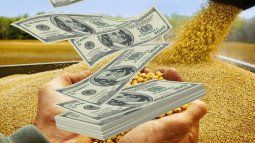The month would close around US$2,500 / US$3,000 million. In just three days, more than $800 million entered.
A key week for the economy begins in which a massive liquidation of agricultural currencies is expected thanks to the new edition of the soybean dollar which has been operating since last Wednesday and in just three days it not only managed to get the BCRA to resume its buying position, but also brought in more than US$800 million and sold just over 400,000 tons of the oilseed.
The content you want to access is exclusive to subscribers.
According to details from the market, the exchange rate established until May 24 of $300 per dollar is speeding up the sales of available grain and tempting those producers who are raising the new harvest. Although prices in the local market did not exceed $105,000 per ton, The selling dynamics woke up strongly as of Thursday, and that is why the export sector awaits a week in which around US$1,500 million would be liquidated.


For the entire month of April, the calculations contemplate the income of between US$2,500 and US$3,000 million. Until mid-May they could reach US$5 billion. Even the Government is betting on exceeding that mark announced by the agro-exporters and The objectives would be to reach US$6,000 million with the commercialization of around 10 million tons.
Although the export program was supposed to start last Monday, pending the regulation of the Ministry of Economy, which arrived on Tuesday and the subsequent opening of the exporters’ accounts, it ended up formally starting last Wednesday. As of this Monday, a daily settlement of no less than US$120 million is then expected, something that would take pressure off the BCRA and allow it to accumulate reserves again. With only three days of liquidation of the field, the Central managed to close last week with a positive balance of US$297 million.
The BCRA had just accumulated more than 20 rounds with a negative balance as a consequence of the fact that the first quarter of this 2023 was marked by the deepening of the drought, with two very strong and extensive heat waves that affected soybean and corn crops. During that period, the field’s foreign exchange income was barely US$2.8 million.
Going forward, the Government seeks, hand in hand with the countryside, to accelerate the income of foreign currency from a soybean harvest that is already known to be lean. According to the latest projection from the Rosario Stock Exchange, the volume harvested would be barely 23 million tons and there may still be more cuts in the medium term. The official strategy is focused on achieving “a bridge” by the end of the year which will also include making the program proposed by the IMF more flexible and the contribution of other credit organizations.
The good news is that the drought has finally come to an end and normal rainfall is expected for the next wheat and barley sowing that would benefit crops that suffered a production cut of around 50% last season. The dollars from the fine grain campaign would begin to enter as of next December and today the big bet is the soybean dollar; then it will be the regional economies.
Source: Ambito




